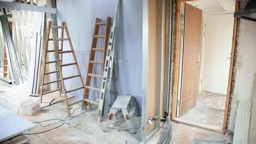One reason Vito Manone purchased his vacation home, located just north of Chicago, was the mesmerizing view. The 7,000-square foot home sits on a 95-foot high bluff overlooking Lake Michigan. Gazing out at the sparkling water was a dream.
But — getting down to it was a nightmare — and some cause for drama. It meant precariously traversing 100 steep stairs straight down to the water — a dreaded task for immediate family and impossible for grandchildren and elderly relatives.
“One missed step would have spelled disaster,” says Manone.
Despite owning three acres of property, only the two acres up on top were accessible. The one acre of bluff and beach couldn’t be reached easily, nor could the beach house that sat down by the water.
Something had to be done. An incline lift seemed like the perfect solution. Manone’s neighbor had installed one without proper permits and subsequently incurred a hefty fine. Lesson learned. Manone opted to follow the rules.
Getting permission
All lift installations require at least a building permit; some also require an electrical permit. The permitting process varies from one week to several months depending on the stringency of codes in a particular area. States such as Michigan, Minnesota and parts of California have implemented strict safety and liability requirements like emergency stops and track bumpers.
Becky Hoefs of Marine Innovations says, “Even though we make this process easy, there may be steps that a client must complete before the incline elevator can be set in place.”
These steps may include satisfying zoning ordinances such as setbacks from water or providing vegetative screening for the car’s landing area. A township may require a simple application be filled out. Some cabin owners may have to work with their state’s natural resources department, the Army Corps of Engineers, the Environmental Protection Agency, the National Scenic River Authority – or not.
“The customer should ask the manufacturer/sales rep in the area to guide them through the process,” says Fred Sulzbach of Door to Shore Inc. “Working with a seasoned expert both encourages progress and eases customer frustration.”
For Manone, that seasoned expert was Jon Shabica, an associate with a consulting firm in Chicago who handles permitting issues for customers seeking access to environmentally sensitive shorelines.
“Jon dealt with all of the bureaucratic red tape,” says Manone. “He got us through the application process, satisfied the issues of the zoning board, as well as other things such as soil testing to prove the bluff was stable.”
Informing thy neighbor
Red tape and permitting headaches are certainly annoying, but perhaps those who have the ability to complicate the process more than anyone else are unhappy (and often uninformed) neighbors who are opposed to the installation of a lift.
“Chances are this neighbor is envisioning a big, bulky, noisy elevator- looking thing that will wreak havoc on the environment and disturb the tranquil lake atmosphere,” says Joe Steinhaus, owner/partner of Incline Car Systems.
It’s a perception that’s way offbase. In actuality, a tram is less intrusive to the land than stairways because it displaces less dirt and requires putting fewer holes and support posts into the ground. In addition, unlike stairs, natural vegetation can grow below the rail system of a tram.
“These are arguments we use with municipalities, too,” says Shabica. “Due to the fact that coastal erosions are unstable, elaborate excavation is needed to put in stairs – but not with lifts.”
It’s helpful to speak with your neighbors before applying for a permit. Once they learn that the lift is minimally disruptive and intrusive from both an environmental and visual standpoint, and that it runs smoothly and very quietly on ball bearing rubber-tired wheels, they’ll likely have no issues. Maybe they’ll even install one!
Defining necessity
Incline lifts aren’t limited to lakes. Steve Cox of Lake Shore Tram says that a fair amount of his business is providing lifts where driveways can’t go.
“Say someone builds a home on top of a rocky crest of a hill. Often times it’s impossible or cost prohibitive to build a traditional driveway and that’s when they’ll consider a lift, especially one with our newly remodeled car.”
The new cars Cox refers to are the ones that provide handicap accessibility as a standard option and have seats that flip up allowing use of the entire floor space. “It’s great for hauling,” says Cox.
To some, these lifts may seem like nothing more than a luxury. But for the mother of a brand new baby, for the person who can no longer manage steps, for the parent with multiple kids under the age of five, and for the owner whose cabin sits hundreds of feet up from the water, a tram is more than a luxury – it is a necessity.
Vito Manone is one customer who is thrilled that his treacherous trek down to the beach is a thing of the past. Now thanks to his lift, he has more than a great view; he has great fun – right down by the water.
Christy Heitger is certain that the “Hey, would ya mind running back up to the cabin to grab the towel?” requests would be met with less resistance by family members if a tram were available.










